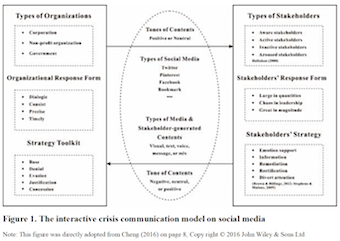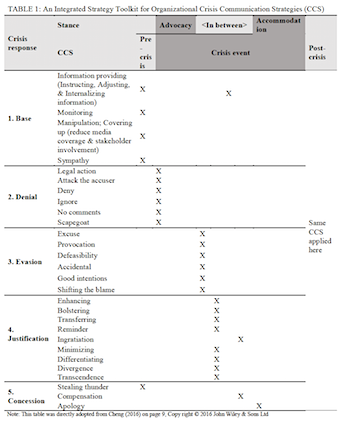|
|
With the increasing use of social media, public relations professionals are tasked with managing organizational crises on multiple online platforms. However, with the ever-evolving digital world, it is difficult for practitioners to make sure that they have used best practices when facing the crisis.
Based on the content analysis of 73 published journal articles on the topic of social media and crisis management, Cheng (2016)’s article examined the crises and crisis communication strategies (CCS) in each study, offered a comprehensive CCS toolkit for the use of organization, and created an “interactive crisis communication” (ICC) model for scholars and practitioners in the field of public relations.
|
|
With the emancipated stakeholders on social media, the ICC model first suggested the importance of measuring stakeholders in the crisis. For example, Cheng (2016) said types of stakeholders (i.e., active, aware, aroused and especially inactive publics), stakeholders’ response forms (i.e., large in quantities, chaos in leadership, great in magnitude and communication strategies (see Figure 1) on social media should be considered and analyzed in the crisis communication.
In the ICC model, “social media was positioned between the organization and stakeholders and worked as an interactive platform for both parties in the crisis. Instead of linearly accepting and transmitting messages at one time from one side, the ICC model recommended a long-time ‘positive dialogue’ between the organization and stakeholders, by connecting links with the third credible party, or chatting online to promote the ‘positive’ feedback (Taylor et al., 2005)” (Cheng, 2016, p. 10).
Second, to provide an integrate strategy toolkit for the crisis management of organizations, the ICC model posited 5 main crisis responses (base, denial, evasion, justification and concession) and included 28 strategies (e.g., attacking the accuser, denial, ignorance, scapegoat, excuse, provocation, defeasibility, accidental, good intentions, stealing thunder, compensation and apology) across the stages of pre-, during, and post-crisis.
|
|
As shown in Table 1, this toolkit integrated both traditional CCS (i.e., excuse, denial, and excuse) and new strategies (e.g., enhancing and transferring) found from crisis communication on social media. Moreover, the ICC model emphasized the ‘dynamics’ in applying this toolkit on the crisis management on social media. Along the defensive–accommodation continuum, the organization could choose any of its stance and strategy in a specific crisis context based on its own benefits and the stakeholder desired strategies (Cheng, 2016).
Third, choosing the right channel to target the right stakeholders is efficient for crisis communication on social media. Since social media has greatly shortened the time for an organization was expected to react (Gilpin, 2010), organizations may choose to use new media such as YouTube and Facebook for crisis responses.
For example, in the 2009 Domino’s YouTube crisis, rather than using the traditional press releases, the Domino’s created a YouTube video as a response to the hoax initiated on same platform (i.e., YouTube) within 24 hours. By choosing the right social media as the channel, the Domino’s first can effectively target on and interact with the stakeholders with negative emotions online (Cheng & Cameron, 2016); second, the managers can respond within the shortest time without waiting for the news reports from traditional media; third, the organization could efficiently transmit messages by using the rich and vivid contents through YouTube.
Last but not least, some new measurement on social media deserved attention in the crisis communication. First, the social media publicity such as attributes of comments/posts and word of mouth could be explored; second, the relationship between organization(s) and blogger(s), blogger(s) and follower(s) or blogger (s) and issue(s) could be explored as well; finally, the economic value such as increased account acceptance and key public engagement could be measured on the social mediated crisis communication (Cheng & Cameron, 2016).
Reference
Cheng, Y. (2016). How social media is changing crisis communication strategies: Evidence from the updated literature. Journal of Contingencies and Crisis Management. DOI: 10.1111/1468-5973.12130. Retrieved from: https://onlinelibrary.wiley.com/doi/10.1111/1468-5973.12130/abstract.
Cheng, Y., & Cameron, G. (2017). The status of social mediated crisis communication (SMCC) research: An analysis of published articles in 2002-2014. In Lucinda Austin and Yan, Jin. (eds.), Social Media and Crisis Communication. Routledge.
Gilpin, D. (2010). Organizational image construction in a fragmented online media environment. Journal of Public Relations Research, 22(3), pp. 265–287.
Taylor, M., & Perry, D.C. (2005). Diffusion of traditional and new Media tactics in crisis communication’, Public Relations Review, Volume 31, pp. 209–217
Figure 1. The interactive crisis communication model on social media
Note: This figure was directly adopted from Cheng (2016) on page 8, Copy right © 2016 John Wiley & Sons Ltd
***
Yang Cheng teaches research methods, strategic communication, and global communication in the U.S. and Hong Kong. Her research interests include social media effects, relationship management, crisis communication, and agenda-setting/building research. Some of her publications have appeared in top journals such as the New media & Society, International Journal of Communication, Public Relations Review, and Asian Journal of Communication. She has also received many awards and honors from global institutions such as the Institute of Public Relations and PRIME research, and has acted as principal investigator in 8 grants including the Arthur Page Johnson Legacy Scholar Grant.

 Yang Cheng
Yang Cheng



 Have a comment? Send it to
Have a comment? Send it to 
No comments have been submitted for this story yet.